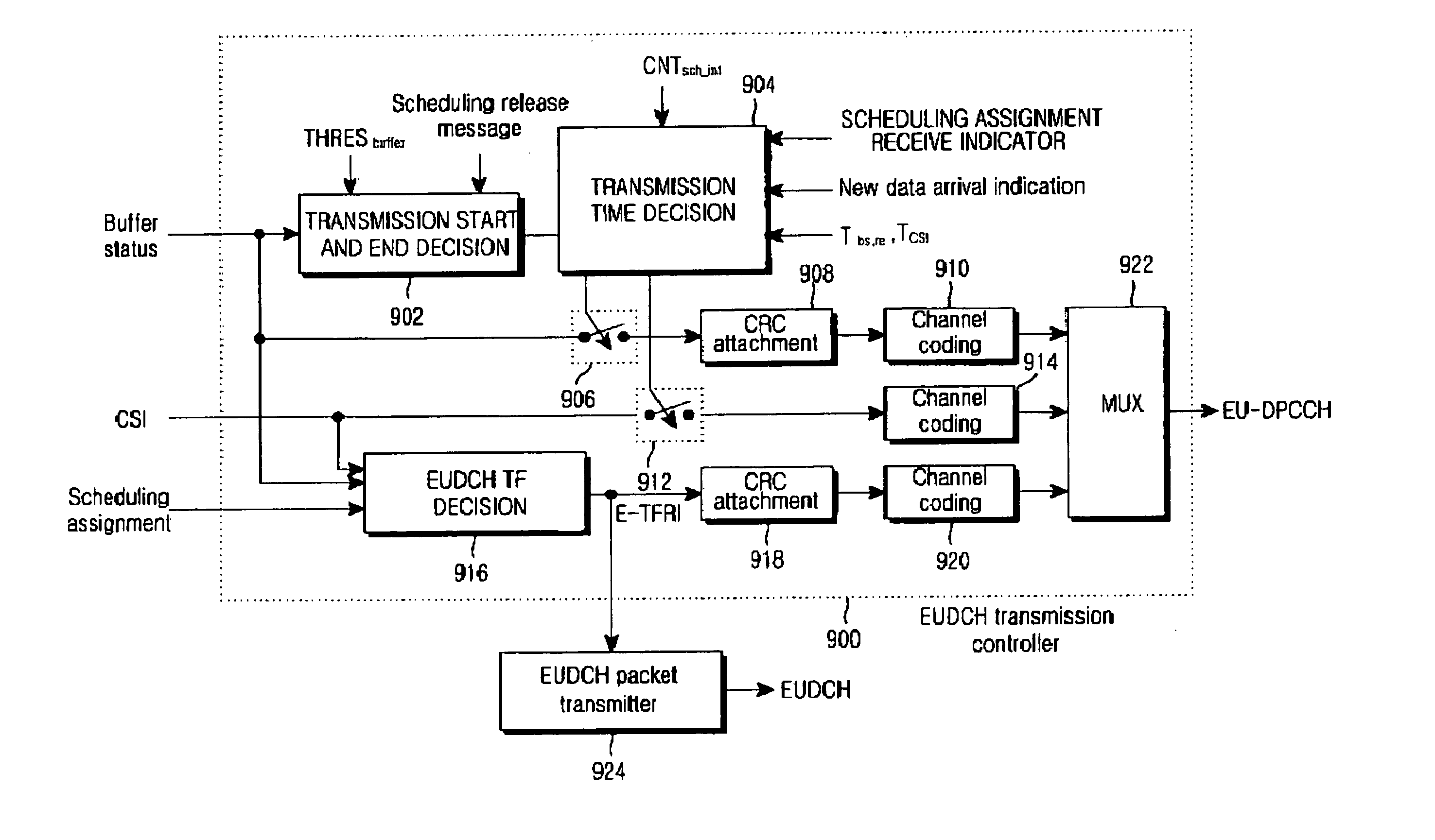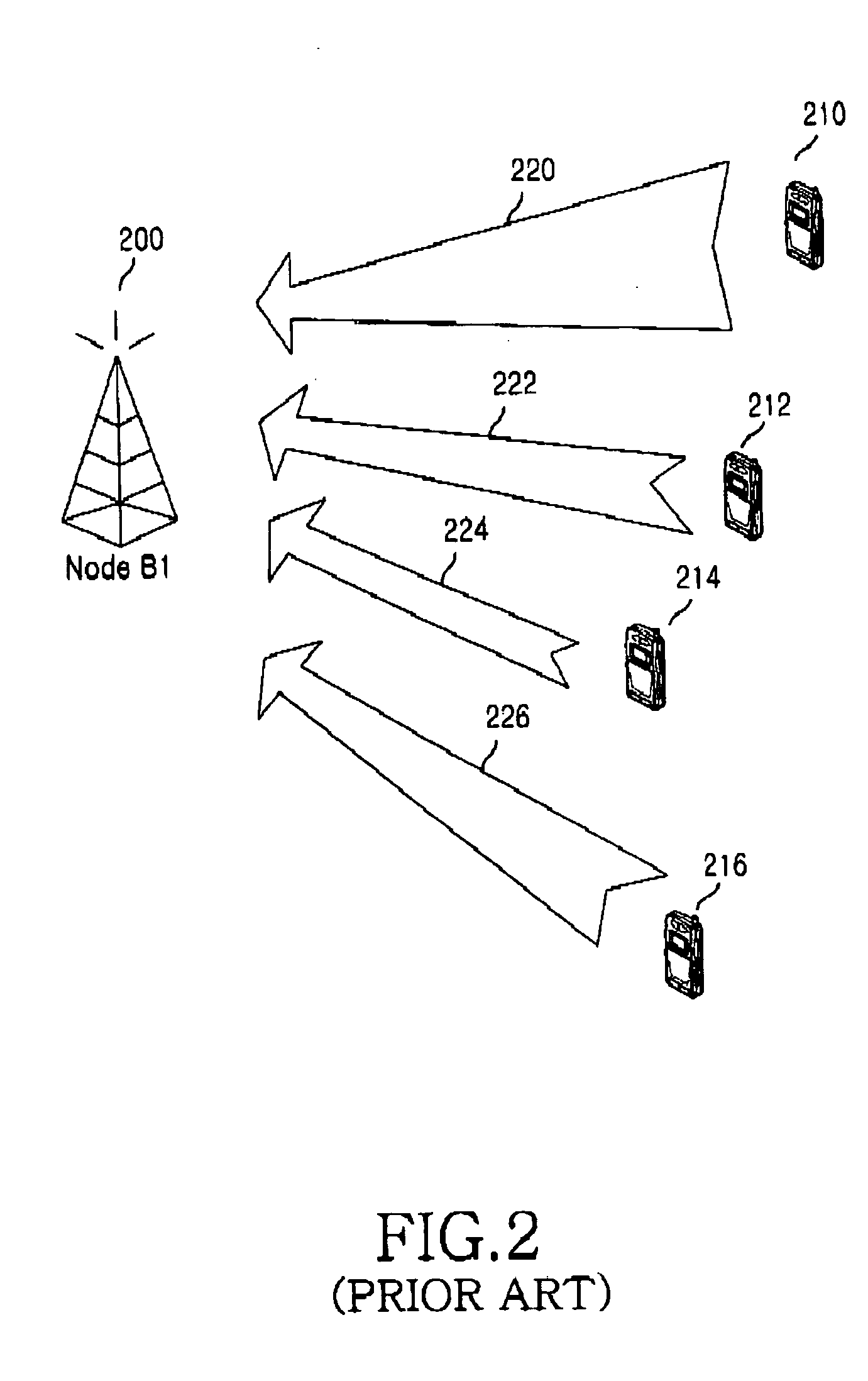Method and apparatus for scheduling uplink packet transmission in a mobile communication system
a mobile communication system and packet transmission technology, applied in the field of mobile communication systems, can solve the problems of degrading the reception performance of the node b, affecting the reception performance of other uplink signals, and affecting the efficiency of the network, so as to reduce the overhead of uplink signals
- Summary
- Abstract
- Description
- Claims
- Application Information
AI Technical Summary
Benefits of technology
Problems solved by technology
Method used
Image
Examples
first embodiment
[0085]FIG. 8 illustrates EU-DPCCH signaling for scheduling assignment between the UE and the Node B according to an embodiment of the present invention. Tsch—int denotes a scheduling interval and each scheduling interval is divided into a buffer status information part and a CSI part. CNTsch—int denotes the index of a scheduling interval. Scheduling intervals with CNTsch—int=10 through CNTsch—int=30 are illustrated in FIG. 8. TCSI and Tbs,re denote a CSI transmission interval and a transmission interval of buffer state information, respectively.
[0086] In a scheduling interval 800 with CNTsch—int=10, the UE initially transmits buffer status information and CSI to the Node B, when determining that the amount of packet data stored in the EUDCH data buffer is at least equal to a scheduling threshold. The Node B generates scheduling assignment information based on the buffer status information and the CSI and transmits the scheduling assignment information in a time period 814. An ROT i...
second embodiment
[0113]FIG. 13 illustrates EU-DPCCH signaling for scheduling assignment between the UE and the Node B according to another embodiment of the present invention. Tsch—int denotes a scheduling interval and each scheduling interval is divided into a buffer status information part and a CSI part. CNTsch—int denotes the index of a scheduling interval. TCSI and Tbuffer denote a CSI transmission interval and a transmission interval of buffer state information, respectively.
[0114] In a scheduling interval 1300 with CNTsch—int=10 the UE initially transmits buffer status information and CSI to the Node B, when determining that the amount of packet data stored in the EUDCH data buffer is at least equal to a scheduling threshold THRESbuffer. The Node B generates scheduling assignment information based on the buffer status information and the CSI and transmits the scheduling assignment information in a time period 1314. An ROT is considered in determining the scheduling assignment information.
[0...
third embodiment
[0139] In a third embodiment of the present invention, the RNC controls the transmission times of buffer status information and CSI for a plurality of UEs in order to prevent the increase of the uplink interference caused by uplink signaling. The RNC controls the UEs to transmit buffer status information and CSI in different scheduling intervals. The transmission times of the buffer status information and CSI are calculated by Equation (3) and Equation (4), respectively,
(CNTsch—int−offsetbuffer)mod(Tbuffer / Tsch—int)=0 (3)
(CNTsch—int−offsetCSI)mod(TCSI / Tsch—int)=0 (4)
where mod is an operator that computes the remainder of the division between two operands, CNTsch—int is a scheduling interval index, and offsetbuffer is an integer specific to each UE to prevent a plurality of UEs from providing the EUDCH service from transmitting buffer status information at the same time and thus increasing the measured ROT of the Node B. Each UE transmits the buffer status information to the ...
PUM
 Login to View More
Login to View More Abstract
Description
Claims
Application Information
 Login to View More
Login to View More - R&D
- Intellectual Property
- Life Sciences
- Materials
- Tech Scout
- Unparalleled Data Quality
- Higher Quality Content
- 60% Fewer Hallucinations
Browse by: Latest US Patents, China's latest patents, Technical Efficacy Thesaurus, Application Domain, Technology Topic, Popular Technical Reports.
© 2025 PatSnap. All rights reserved.Legal|Privacy policy|Modern Slavery Act Transparency Statement|Sitemap|About US| Contact US: help@patsnap.com



